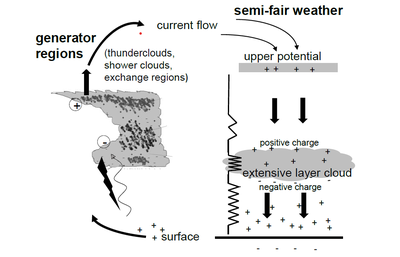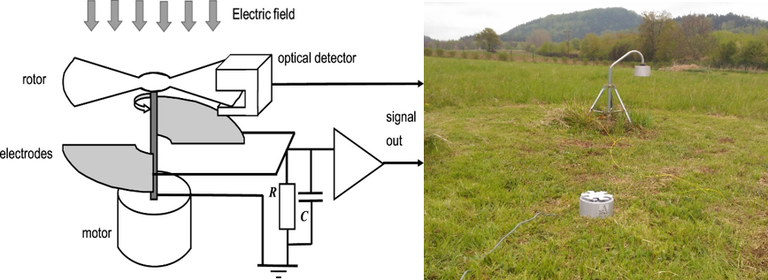Field mill for the measurement of atmospheric electricity
Every time we walk outside, we are bathed in force fields that are produced by nature. They are gravitational, magnetic and electric fields. The electrostatic field is a consequence of a potential difference (around 250 kV) between the electrically conducting ionosphere and the Earth. This potential difference results from charge separation in clouds, usually in thunderclouds, as it is conceptually shown in the Figure 1.

Figure 1. Picture of the global atmospheric electric circuit, in which a current is generated in disturbed weather regions, and returns through distant fair weather and semi-fair weather regions. As the current returns through extensive layer clouds, charges accumulate at their upper and lower boundaries (Credits: Harrison, 2021).
A typical value of electric field intensity in an open, flat terrain at the ground during fair weather is about 100 V/m. Local weather – charged thunderclouds – cause distinct changes of the local electric field. Consequently, the local electric field can reach values of several kV/m, and even about 100 kV/m at prominent high-mountain peaks. At high latitudes, the interplanetary magnetic field in the solar wind might also contribute to the potential difference.
A field mill (Figure 2) is a specialised instrument that can be used to measure the strength of the electric field in the atmosphere, one of the key parameters of atmospheric electricity. This information is used as a launch criterion for rockets bound for orbit, to avoid lightning strikes.
Normally, it is most convenient to ground the instrument, making the sensing electrode at earth ground potential when measuring the vertical component of atmospheric electric field at the surface of the earth. This is because the instrument then appears to be an extension of the earth ground.

Figure 2. A simplified schematic showing the basic elements required for an electric field mill using an earthed rotating shutter (on the left). The field mill installed at Panska Ves observatory in the Czech Republic (on the right).
How does the mill manage to measure the static field generated by the atmosphere? Simple: it turns the static field into a changing one. This is done with the grounded rotor, which acts as a Faraday cage and shields the electric field underneath it. As it turns, it continuously covers and uncovers the electrodes. The external electric field induces a potential in the electrodes each time they are uncovered, which disappears again when they are covered again by the rotor. The output voltage from this oscillating signal is directly proportional to the earth’s field. The records in mV can be converted directly into field readings in V/m. A typical fine day outdoor graph is given in Figure 3.

Figure 3. Typical fine day outdoor graph based on measurements of atmospheric electricity at Panska Ves.
